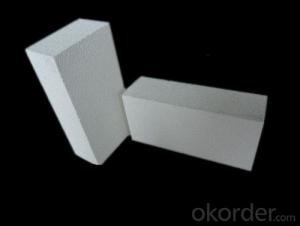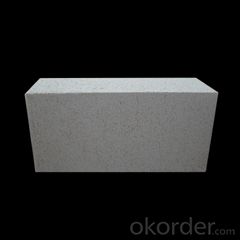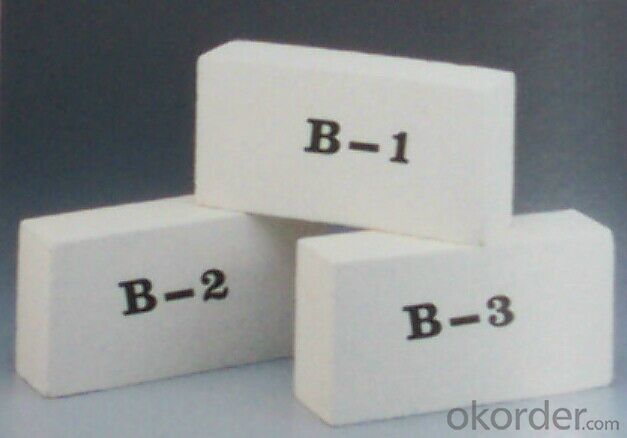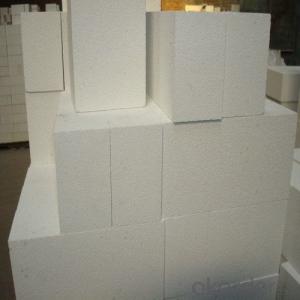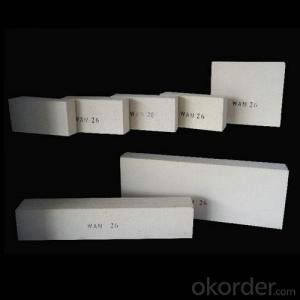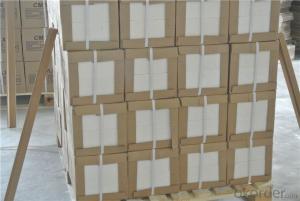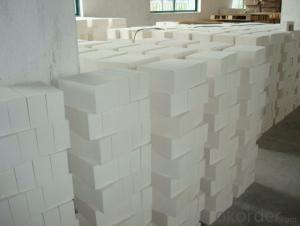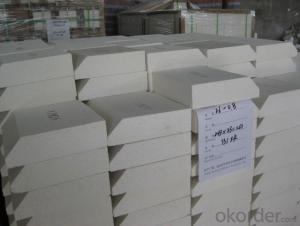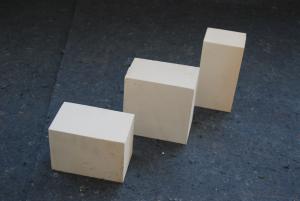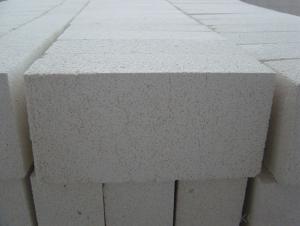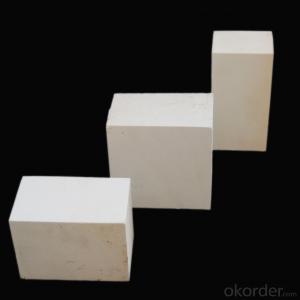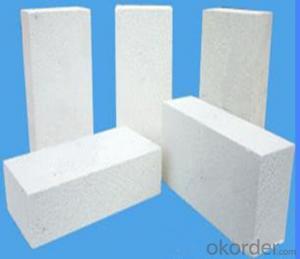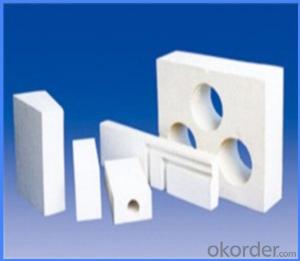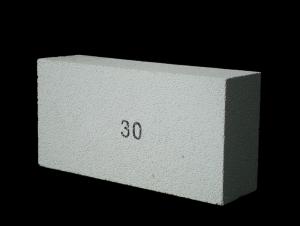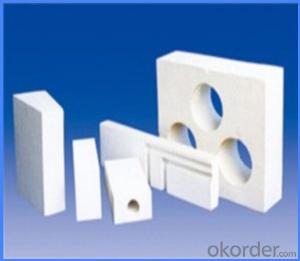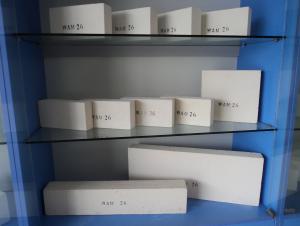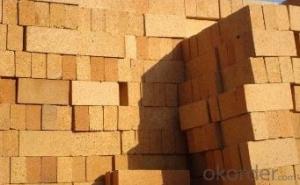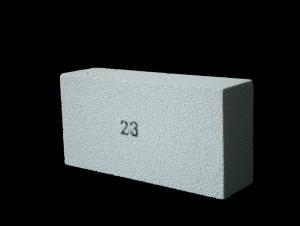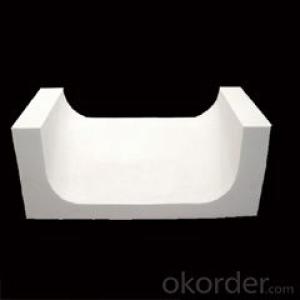Insulating Fire Brick - Refractory JM Mullite Insulation Brick B-1
- Loading Port:
- Shanghai
- Payment Terms:
- TT OR LC
- Min Order Qty:
- 10 m.t.
- Supply Capability:
- 1000 m.t./month
OKorder Service Pledge
OKorder Financial Service
You Might Also Like
Specifications
1. Low density.
2. Classification temperature:1610-1780.
3. Thermal insulation energy-saving effect is good.
High alumina insulation brick,Insulation brick,Fireclay insulation brick
Features:
1. Low thermal conductivity.
2. High strength and resistance to corrosion.
3. Low heat capacity.
4. Low shrinkage after heavy firing.
5. High insulation.
6. High refractoriness.
7. Low density.
8. Good thermal shock resistance under high temperature.
9. Thermal insulation energy-saving effect is good.
Physical and chemical index:
Application:
Insulation brick can be widely used for lining or insulation layers of various industrial furnaces and kilns in metallurgical industry, machine building industry, ceramic industry, chemical industry.
Refractory mullite insulating refractory brick JM 23
Okorder series heat insulation brick
Okorder series thermal insulation brick is an effective, energy saving, low carbon, environmental protection advanced, according to the ASTM standard manufacturing products. Okorder series products are best Li Ning and insulation in all types of industrial furnaces in the metallurgical field, aluminum, petrochemical, electric power and glass ceramic materials. They can be used as part of the working layer of thermal insulation or non - melting. Products have been widely used in the following furnace, achieved satisfactory results.
Application of heat preservation brick
Metallurgical Industry: blast furnace, hot blast furnace, heating furnace, etc..
Petrochemical Industry: ethylene cracking furnace, hydrogen production furnace, primary reformer, heating furnace, etc..
Ceramic industry: roller kiln, kiln, etc..
Glass industry: glass furnace regenerator, etc.
Carbon industry: carbon furnace, etc..
Aluminum electrolysis industry: aluminum reduction cell, etc.
Other industries: tunnel kiln, shuttle kiln, etc..
Advantages of heat insulation brick
Low thermal conductivity: more porosity will bring good thermal insulation effect, energy saving.
High crushing strength: high crushing strength, volume stability.
Low heat storage: small heat storage to absorb more heat, energy-saving effect is obvious.
Gao Chundu: iron, alkali metal impurity content is low.
The precise size: Brick size processing precision, special shape cutting and grinding, accelerate the brickwork.
Insulating brick picture
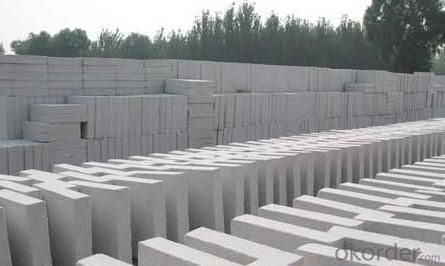
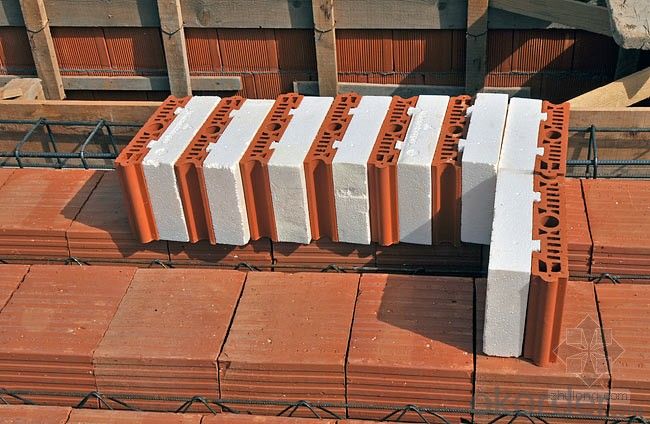
Common problem solutions
1. What products do you have?
We have all kinds of refractory bricks, refractory casting materials, mortar, cement, ceramic fiber products, etc..
Or you can browse our products to choose what you need.
2. How to control product quality?
With strict quality control system throughout the material selection and production process, we have the quality of refractory materials and ceramic fiber products to meet customer requirements.
From the selection of raw materials, the quality of our control to start. The quality certificate of the raw material is required, each batch of the products are to be tested in the use of the forward line. In the production process, the quality control by the workers, and then each piece of classification, and through the quality supervision and inspection.
3. Can you give me a brief introduction to the application of your product?
My company is mainly engaged in refractories in the steel, cement, glass, ceramics, petrochemical, electric power and other industries.
4. What information do you need if I need you?
In order to select the right products, we will provide us with information, such as the United States, technical data, order quantity, product application, etc..
If you have any questions, please contact us.
- Q: Can insulating fire bricks be used for insulation in heat recovery systems?
- Yes, insulating fire bricks can be used for insulation in heat recovery systems. These bricks have high thermal resistance, low thermal conductivity, and can withstand high temperatures, making them suitable for insulating and retaining heat in heat recovery systems.
- Q: Do insulating fire bricks have low thermal conductivity?
- Yes, insulating fire bricks have low thermal conductivity.
- Q: Can insulating fire bricks be used in cryogenic applications?
- Insulating fire bricks, also known as refractory bricks, are primarily designed for high-temperature applications and are commonly used in furnaces and kilns. However, when it comes to cryogenic applications, where extremely low temperatures are involved, insulating fire bricks may not be the most suitable choice. Cryogenic temperatures, typically below -150 degrees Celsius (-238 degrees Fahrenheit), pose unique challenges for materials due to the severe thermal stresses they experience. Insulating fire bricks are typically composed of materials such as alumina and silica, which have limited thermal shock resistance and can become brittle at very low temperatures. This brittleness can lead to cracking and failure when exposed to cryogenic conditions. Additionally, insulating fire bricks have relatively high thermal conductivity, which means they can conduct heat relatively well. In cryogenic applications, where minimizing heat transfer is crucial, materials with lower thermal conductivity are preferred. Therefore, insulating fire bricks, with their higher thermal conductivity, may not be the most efficient choice for cryogenic applications. Instead, materials with excellent thermal insulation properties and low thermal conductivity, such as aerogels or foams made from materials like silica or carbon, are often preferred for cryogenic applications. These materials offer superior thermal insulation and better resistance to extreme temperatures, ensuring the efficient and reliable performance required in cryogenic environments. In summary, while insulating fire bricks are suitable for high-temperature applications, they may not be the best choice for cryogenic applications due to their brittleness at low temperatures and relatively high thermal conductivity. Materials specifically designed for cryogenic conditions, such as aerogels or foams, are more suitable for these extreme temperature environments.
- Q: Are insulating fire bricks resistant to acids?
- Yes, insulating fire bricks are generally resistant to acids. They are made from materials that can withstand high temperatures and are chemically stable, making them suitable for applications where acid resistance is required.
- Q: Can insulating fire bricks be used in the construction of aluminum smelting furnaces?
- Yes, insulating fire bricks can be used in the construction of aluminum smelting furnaces. Insulating fire bricks are made from lightweight materials such as refractory clay and have high insulating properties. This makes them ideal for use in high-temperature environments, such as aluminum smelting furnaces, where they can help to conserve heat and improve energy efficiency. Aluminum smelting furnaces typically operate at very high temperatures, often above 1000 degrees Celsius. In these extreme conditions, insulating fire bricks can provide effective thermal insulation, which helps to reduce heat loss and maintain the desired temperature inside the furnace. This insulation can also help to reduce the energy required to heat the furnace, leading to cost savings and increased efficiency. Additionally, insulating fire bricks have excellent resistance to thermal shock, meaning they can withstand rapid temperature changes without cracking or breaking. This is important in an aluminum smelting furnace, where the heating and cooling cycles can be frequent and rapid. Another advantage of using insulating fire bricks in aluminum smelting furnaces is their low thermal conductivity. This property allows them to retain heat within the furnace, preventing it from escaping to the surrounding environment. By reducing heat loss, insulating fire bricks can help to maintain a consistent temperature throughout the smelting process, ensuring optimal conditions for the melting and refining of aluminum. In summary, insulating fire bricks are a suitable choice for the construction of aluminum smelting furnaces due to their high insulating properties, resistance to thermal shock, and low thermal conductivity. Their use can help to improve energy efficiency, reduce heat loss, and maintain a stable temperature within the furnace.
- Q: Are insulating fire bricks suitable for use in high-temperature chimneys?
- Indeed, high-temperature chimneys can indeed benefit from the utilization of insulating fire bricks. These bricks are purposefully crafted to endure drastic temperatures and offer superb insulation characteristics. With their elevated melting point and reduced thermal conductivity, they possess the ability to proficiently retain heat and obstruct its escape through the chimney walls. Consequently, this aids in maintaining a desirable temperature within the chimney, a pivotal factor for optimal combustion and efficient chimney operation. Furthermore, insulating fire bricks possess the advantageous qualities of being lightweight and long-lasting, rendering them an impeccable selection for constructing chimneys that are subjected to elevated temperatures.
- Q: Are insulating fire bricks resistant to thermal spalling?
- Yes, insulating fire bricks are resistant to thermal spalling. Thermal spalling refers to the phenomenon where a material cracks or breaks due to rapid temperature changes or thermal shock. Insulating fire bricks are specially designed to withstand high temperatures and thermal cycling without spalling. They have a low thermal conductivity, which means they can effectively insulate against heat transfer and minimize the stress caused by thermal expansion and contraction. Additionally, the composition and structure of insulating fire bricks are engineered to provide excellent resistance to thermal spalling, making them a reliable choice for applications that involve extreme heat conditions.
- Q: Can insulating fire bricks be used in fireplaces?
- Yes, insulating fire bricks can be used in fireplaces. Insulating fire bricks are specifically designed to withstand high temperatures and provide excellent insulation, making them suitable for use in fireplaces. They are capable of withstanding temperatures up to 3000°F (1650°C), which is well within the operating range of most fireplaces. These bricks are made from special materials that have low thermal conductivity, allowing them to retain heat and prevent it from escaping the fireplace. This insulation property helps to improve the efficiency of the fireplace by keeping the heat inside the firebox and preventing it from dissipating into the surrounding area. Additionally, insulating fire bricks are lightweight, durable, and easy to install, making them a popular choice for fireplace construction or renovation projects.
- Q: Can insulating fire bricks be used in contact with molten metals?
- Yes, insulating fire bricks can be used in contact with molten metals. Insulating fire bricks are designed to handle high temperatures and can withstand the heat generated by molten metals. They have excellent insulation properties and can effectively protect against heat transfer, making them suitable for various applications involving molten metals.
- Q: Are insulating fire bricks resistant to hydrofluoric acid?
- Insulating fire bricks are not resistant to hydrofluoric acid. Hydrofluoric acid is a highly corrosive substance that can attack and dissolve many materials, including fire bricks. It is important to handle hydrofluoric acid with extreme caution and use appropriate protective equipment when working with this hazardous substance.
Send your message to us
Insulating Fire Brick - Refractory JM Mullite Insulation Brick B-1
- Loading Port:
- Shanghai
- Payment Terms:
- TT OR LC
- Min Order Qty:
- 10 m.t.
- Supply Capability:
- 1000 m.t./month
OKorder Service Pledge
OKorder Financial Service
Similar products
Hot products
Hot Searches
Related keywords
